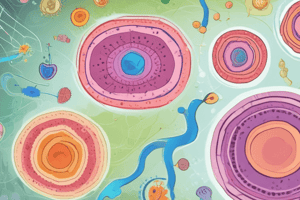Podcast
Questions and Answers
The ______ is a jelly-like substance inside the cell.
The ______ is a jelly-like substance inside the cell.
cytoplasm
______ is the process by which cells take in nutrients.
______ is the process by which cells take in nutrients.
Absorption
Plant cells use ______ to capture sunlight for photosynthesis.
Plant cells use ______ to capture sunlight for photosynthesis.
chloroplasts
The ______ helps in transporting materials within the cell.
The ______ helps in transporting materials within the cell.
______ cells have a defined shape due to the cell wall.
______ cells have a defined shape due to the cell wall.
The ______ controls what enters and leaves the cell.
The ______ controls what enters and leaves the cell.
Bacteria are ______ organisms.
Bacteria are ______ organisms.
The ______ is known as the control center of the cell.
The ______ is known as the control center of the cell.
Flashcards
What is a cell?
What is a cell?
The basic, fundamental unit of life, responsible for all life processes.
What is the cell membrane?
What is the cell membrane?
A thin, flexible barrier that surrounds the cell, controlling what enters and exits.
What is cytoplasm?
What is cytoplasm?
A jelly-like substance that fills the cell and contains organelles.
What is the mitochondria?
What is the mitochondria?
Signup and view all the flashcards
What is the nucleus?
What is the nucleus?
Signup and view all the flashcards
What are chloroplasts?
What are chloroplasts?
Signup and view all the flashcards
What are ribosomes?
What are ribosomes?
Signup and view all the flashcards
What is a prokaryotic cell?
What is a prokaryotic cell?
Signup and view all the flashcards
Study Notes
Cell Structure and Function
- Basic Unit of Life: The cell is the fundamental unit of life.
- Cell Control Center: The cell membrane regulates what enters and leaves the cell.
- Plant Cell Differences: Plant cells possess a cell wall, absent in animal cells.
- Energy Production Organelle: Mitochondria produce energy for cells.
Additional Cell Information
- Cell Membranes: Cell membranes are not rigid and allow movement.
- Chloroplasts: Chloroplasts are found in plant, not animal, cells.
- Cell Division: Cells reproduce by division.
- Unicellular Organisms: Bacteria are unicellular organisms.
- Cytoplasm: The cytoplasm is a jelly-like substance inside the cell.
- Nutrient Intake: Cells take in nutrients via a process.
- Photosynthesis: Plants utilize photosynthesis to capture sunlight's energy.
- Intracellular Transport: The cell has a system to transport materials.
- Cell Shape: Cell walls provide structural support, defining cell shapes.
Cell Types and Processes
- Prokaryotic vs. Eukaryotic Cells: Prokaryotic cells lack a nucleus, while eukaryotic cells have a nucleus.
- Ribosomes: Ribosomes synthesize proteins within cells.
- Cell Membrane Function: The cell membrane helps maintain homeostasis (internal balance).
- Vacuole Function (Plant Cells): Plant vacuoles are involved in storing and maintaining turgor pressure.
Cell Processes and Implications
- Cell Importance: Cells are essential for the function of organisms.
- Tissue and Organ Function: Cells contribute to the functioning of tissues and organs.
- Stem Cells: Stem cells are important because they have the ability to differentiate into various cell types.
- Cell Structure and Function Relationship: A cell's shape and structure are correlated with its function.
- Semi-permeable Membranes: Cell membranes are semi-permeable, allowing certain substances to pass through.
- Cell Size and Function: Cell size influences its function, impacting efficiency.
- Cell Division and Growth: Cell division is critical for growth and repair.
- Cell Communication: Cells communicate with each other to regulate processes and functions.
- Environmental Impact on Cell Function: Environmental factors affect cell function and behavior.
Organelle Functions
- Organelle Matching: (Note: The provided question list for matching has additional information that needs to be included to provide full, accurate matching, requiring the specifics for each organelle and its associated function)
Processes and Questions
- Protein Synthesis: Questions focus on protein synthesis processes.
- Energy Production and Bacterial Cells: The impact of energy production disruption and antibiotic effects.
- Cell Adaptations: How cells might react when missing or malfunctioning parts.
- Ethical Considerations: Stem cells and their ethical implications are discussed.
- Cell Biology and Medicine: The relationship between cell biology advancements and medicine's impact is a focus.
- Cell Theory Components: Key parts of the cell theory are covered.
- Multicellular vs. Unicellular Organisms: Key distinctions and characteristics are highlighted.
- Cell Study Techniques: Techniques for studying cells are discussed.
- Organelle Functions: A summary of the key functions of cell organelles is provided.
Studying That Suits You
Use AI to generate personalized quizzes and flashcards to suit your learning preferences.




